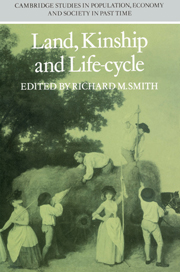Book contents
- Frontmatter
- Contents
- List of contributors
- Preface
- 1 Some issues concerning families and their property in rural England 1250–1800
- 2 Population pressure, inheritance and the land market in a fourteenth-century peasant community
- 3 Families and their land in an area of partible inheritance: Redgrave, Suffolk 1260–1320
- 4 Population changes and the transfer of customary land on a Cambridgeshire manor in the fourteenth century
- 5 Industrial employment and the rural land market 1380– 1520
- 6 Changes in the size of peasant holdings in some west midland villages 1400–1540
- 7 The erosion of the family–land bond in the late fourteenth and fifteenth centuries: a methodological note
- 8 Changes in the link between families and land in the west midlands in the fourteenth and fifteenth centuries
- 9 Kinship in an English village: Terling, Essex 1550–1700
- 10 The myth of the peasantry: family and economy in a northern parish
- 11 Poverty, poor relief and the life-cycle: some evidence from seventeenth-century Norfolk
- 12 The receipt of poor relief and family situation: Aldenham, Hertfordshire 1630–90
- 13 Widows in pre-industrial society: an essay upon their economic functions
- 14 Real property, marriage and children: the evidence from four pre-industrial communities
- 15 The nineteenth-century peasantry of Melbourn, Cambridgeshire
- Consolidated Bibliography
- Index
12 - The receipt of poor relief and family situation: Aldenham, Hertfordshire 1630–90
Published online by Cambridge University Press: 19 October 2009
- Frontmatter
- Contents
- List of contributors
- Preface
- 1 Some issues concerning families and their property in rural England 1250–1800
- 2 Population pressure, inheritance and the land market in a fourteenth-century peasant community
- 3 Families and their land in an area of partible inheritance: Redgrave, Suffolk 1260–1320
- 4 Population changes and the transfer of customary land on a Cambridgeshire manor in the fourteenth century
- 5 Industrial employment and the rural land market 1380– 1520
- 6 Changes in the size of peasant holdings in some west midland villages 1400–1540
- 7 The erosion of the family–land bond in the late fourteenth and fifteenth centuries: a methodological note
- 8 Changes in the link between families and land in the west midlands in the fourteenth and fifteenth centuries
- 9 Kinship in an English village: Terling, Essex 1550–1700
- 10 The myth of the peasantry: family and economy in a northern parish
- 11 Poverty, poor relief and the life-cycle: some evidence from seventeenth-century Norfolk
- 12 The receipt of poor relief and family situation: Aldenham, Hertfordshire 1630–90
- 13 Widows in pre-industrial society: an essay upon their economic functions
- 14 Real property, marriage and children: the evidence from four pre-industrial communities
- 15 The nineteenth-century peasantry of Melbourn, Cambridgeshire
- Consolidated Bibliography
- Index
Summary
Since Louis Henry pioneered the technique of family reconstitution over twenty years ago and E. A. Wrigley adapted it to fit English parish registers, our knowledge of the functioning of the family as a reproductive unit has advanced considerably. Much less progress has been made in linking information on the reconstituted families with other parochial sources, which will give us a fuller impression of past family life than could be derived from one source taken in isolation.
The reconstitution of families in the Aldenham parish registers dating from 1560 can, like every other reconstitution, be illuminated by the integration of other material such as records of estate transactions, the sale and purchase of property, subsidies, taxes of various kinds and the listing of inhabitants of the parish in whole or in part according to the requirements of legislation devised for a variety of purposes. For the most part these records refer either to a specific event of relatively transitory significance to the reconstitution (such as an election) or endure for relatively short periods (e.g. Hearth and Poll Taxes, or Militia Rolls).
One enactment, however, of universal application survived the passage of over two centuries and remains the basis of local finance to the present time.
- Type
- Chapter
- Information
- Land, Kinship and Life-Cycle , pp. 405 - 422Publisher: Cambridge University PressPrint publication year: 1985
- 4
- Cited by

